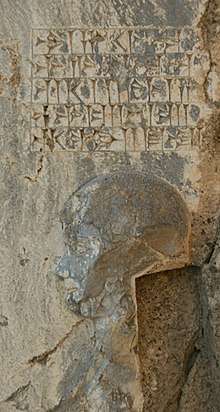Açina
Açina, also ššina, was one of the last kings of the kingdom of Elam, and ruled briefly in 522 BCE. He was toppled by Darius I and later depicted in chains in the Behistun Inscription.[2]
According to Darius in his inscription:
King Darius says: After I had slain Gaumâta, the Magian, a certain man named ššina, the son of Upadarma, raised a rebellion in Elam, and he spoke thus unto the people of Elam: 'I am king in Elam.' Thereupon the people of Elam became rebellious, and they went over unto that ššina: he became king in Elam. And a certain Babylonian named Nidintu-Bêl, the son of Kîn-Zêr, raised a rebellion in Babylon: he lied to the people, saying: 'I am Nebuchadnezzar, the son of Nabonidus.' Then did all the province of Babylonia go over to Nidintu-Bêl, and Babylonia rose in rebellion. He seized on the kingdom of Babylonia. King Darius says: Then I sent (an envoy?) to Elam. That ššina was brought unto me in fetters, and I killed him.
Popular culture
- Acina is the name of the incumbent Sith Empress in the MMORPG known as Star Wars: The Old Republic.
See also
References
- Behistun, minor inscriptions DBb inscription- Livius.
- Potts, D. T. (2015). The Archaeology of Elam: Formation and Transformation of an Ancient Iranian State. Cambridge University Press. p. 316. ISBN 9781107094697.
- Kuhrt, Amélie (2013). The Persian Empire: A Corpus of Sources from the Achaemenid Period. Routledge. p. 144. ISBN 9781136016943.
